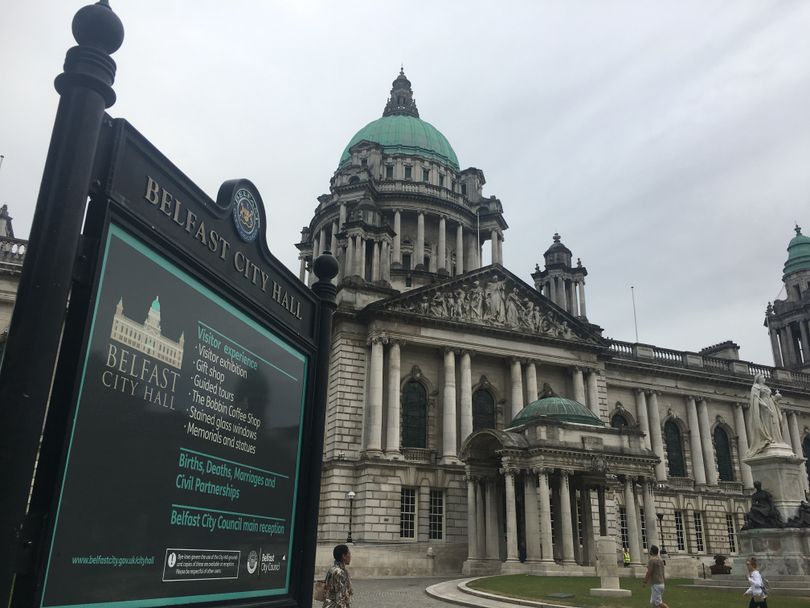Belfast: a bustling city with a proud past

Like many travelers, my wife and I try to get an initial sense of a city by looking for a Hop-on Hop-off bus tour. They’re relatively cheap, easy to navigate and in most cases give you a good overview of the city in question.
We’ve taken them in Rome, Barcelona, Sydney, Dublin, Sevilla (Spain), Mexico City, Cape Town, Auckland (New Zealand) and Porto (Portugal). We would have done the same in Lisbon, but it was a lot easier just to contract with a Tuk-tuk driver – the streets in that city being way too narrow and steep for a the company’s trademark double-decker bus to navigate.
During the trip to Ireland that we took in the summer of 2018, I insisted that we go up to Northern Ireland, too. I’d read for years about the conflicts between the Protestants and Catholics in Belfast, aka The Troubles, and I wanted to see the place for myself.
(Quick book recommendation here: I’ve read all of Adrian McKinty’s Sean Duffy novels, seven as of now with two more in the works. Duffy is a Royal Ulster Constabulary detective, a Catholic working in the primarily Protestant police force during the 1980s. McKinty debuted him in 2012’s “The Cold, Cold Ground.”)
Back to our visit, we took the train from Dublin and a little more than two hours later we arrived . Even though this was before Brexit, I wasn’t sure whether there would be a stop at the border. But we sailed right through. (I’ve had more trouble crossing the state line from Oregon to California, being interrogated by California state officials about any fruit that I might be bringing in.)
Once we cabbed from the train station to our hotel, the Malmaison, we dropped off our bags and looked for the nearest Hop-on Hop-off stop, which was only a few blocks away. After standing in line awhile to buy tickets, we boarded and found seats on the top deck of one of the company’s typical red buses.
Among the 19 or so sights we passed by: Titanic Belfast, St. George’s Market, the so-called Solidarity Wall, the Peace Wall and the famous Belfast City Hall.
I’m not going to do a survey of the sectarian violence that marked the city, indeed the whole country, for decades, pitting Catholics against Protestants in an ever-evolving and ongoing struggle that continues to this day. Whole books have been written on that subject.
I will say, though, that even after the 1998 Good Friday Agreement, the city remains largely segregated, with banners and murals blaring separatist sentiments, all of which can easily be seen from the tour-bus windows.
I will give a very brief overview of Belfast’s status as a shipbuilding empire. Starting in 1791, when a Scot named William Ritchie came to the area, started his business and built a ship, the 300-ton Hibernian, Queen’s Island – known these days also as the Titanic Quarter – began attracting more and more business, especially after dredging gave the city better access to the ocean.
By 1861, the legendary company Harland & Wolff – owned and managed by Edward James Harland and Gustav Wolff – had been founded. And over the next three decades, H&W expanded from a 1.5-acre enterprise that employed 100 men to an 80-acre behemoth that employed 10,000.
Here’s a quote from the BBC: “By the early 20th Century, Harland and Wolff dominated global shipbuilding and had become the most prolific builder of ocean liners in the world.”
Of course, things changed as the century progressed. Competition hurt the company’s finances, with both international companies cutting into the city’s shipbuilding business and travelers turning more to airlines to arrive at their destinations quicker and cheaper.
So, though H&W had built more than 1,000 ships, including the Titanic, and during World War II had built some 140 warships, 123 merchant ships and more than 500 tanks, the company hit hard times. It still exists, though, its trademark yellow cranes visible all over the Titanic Quarter.
And the area itself has seen a resurgence, thanks both to the interactive museum Titanic Experience, which attracts a reported 6.5 million visitors a year (Mary Pat and I among them) and to its use as a shooting site for movies and television shows (part of “Game of Thrones” was filmed near there).
The Titanic Experience is well worth checking out as it gives you a sense of what it might have been like to be a passenger on the doomed liner. As is the St. George’s Market (which dates back to 1604 and features as many as 200 stalls offering, according to one website, “fruit, vegetables, antiques, books, clothes, hot food, cakes and buns, crafts and a large selection of fresh fish”).
Finally, there’s Belfast City Hall, built to a design by the architect Sir Alfred Brumwell Thomas and completed in 1906. On the grounds the Renaissance-style building are statues both of Queen Victoria and H&W co-founder Edward Harland, along with a memorial to those who went down on the Titanic.
It seemed to me only fitting, though, that I would be attracted to a message that I saw in the City Hall gift shop. This is what it said:
“I don’t care if you’re Protestant, Catholic – I don’t care who you are or what you are – your grief is still the same.”
That’s a message that could apply to pretty much every conflict in today’s world.
